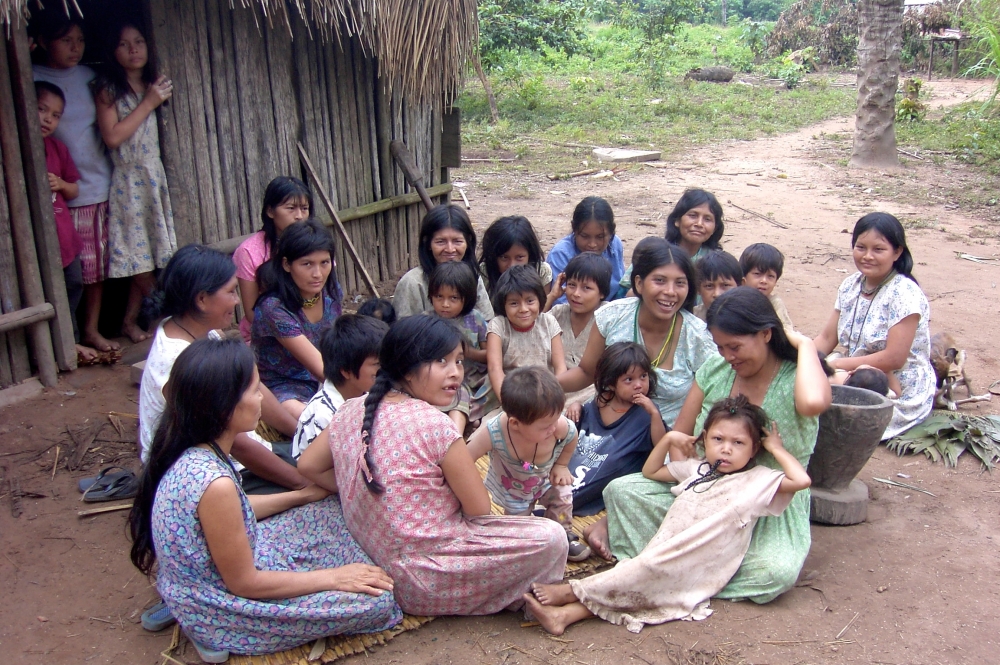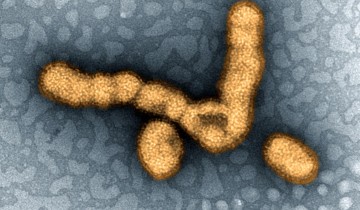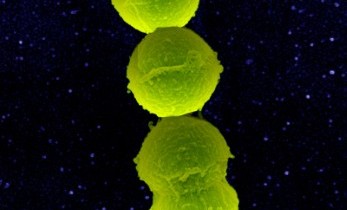The Tsimane of Bolivia are an isolated Amazonian indigenous community inhabiting a vast area of lowland forests. They make a living mostly through swidden agriculture, hunting, fishing, and gathering. Their average birth rate, which is relatively high — nine children per woman — has inspired a new study, published in the journal Science (November 20, 2015). The study results show that infection with parasitic worms could help or harm a woman’s fertility, depending on the type of worm.
Parasitic worms — also known as soil-transmitted helminths or intestinal worms — cause some of the most common parasitic infections worldwide. According to the World Health Organization (WHO), approximately 2 billion people are infected with soil-transmitted helminths globally, mostly in the poorest and most deprived communities. They are transmitted by eggs present in human feces, which in turn contaminate soil in areas where sanitation is poor.
The main species of soil-transmitted helminths that infect people are the roundworm (Ascaris lumbricoides), the whipworm (Trichuris trichiura), and hookworms (Necator americanus and Ancylostoma duodenale). Adult worms live in the intestine where they produce thousands of eggs each day. In areas that lack adequate sanitation, these eggs contaminate the soil. Once infected, individuals usually have no symptoms. However, infection can contribute to anemia, vitamin A deficiency, malnutrition, impaired growth, delayed development, and intestinal blockages.
The new study shows that the Tismane women infected with roundworm were more likely to become pregnant, and had up to two more children than those without infection, whereas women infected with hookworm were less likely to become pregnant, and had up to three fewer children than uninfected women.
The researchers think that these opposing effects are likely due to the different interactions of roundworms and hookworms with the immune system, which in turn affects the likelihood of conception. Healthy pregnancy is associated with shifts in immune responses, with an increase in regulatory and helper T cell type 2 (TH2) activity. This activity helps to suppress helper T cell type 1 (TH1) responses, thus increasing maternal tolerance of the fetus. Indeed, the mother’s immune system sees the fetus as a foreign entity, and it could otherwise reject it using the TH1 responses.
Parasitic infections that induce systemic immunological changes affect fertility by altering the immune response of the infected women — helper T cell populations generally shift from TH1 toward TH2 responses, and the suppressive activity of regulatory T cells increases to modulate both TH1 and TH2 responses.
The immune response to the roundworm could be more favorable to conception and embryo implantation because it more closely resembles the immunological state in pregnancy, and less closely the one that suppresses fertility.
Michael Gurven, one of the study authors, said in a press release: “This study examines yet another domain where helminths and their regulatory effect on the immune system may be relevant to broader aspects of health and well-being, Although we don’t know the precise mechanism behind these results, our findings are still compelling and suggest that immune modulation — via our ‘old friends’ the intestinal worms — can have far-reaching effects on the body, even though the findings may be less applicable in developed populations where women only have a few children over their lifetime.”





In skimming through the mechanisms presented by Dr. Blackwell’s paper and related information both referenced by and related to the way parasites may influence the immune system, it appears that in general the Th1 response is downregulated by extracellular parasites agents who through their antigens shift the adaptive response towards a Th2 mediated one geared towards allergy and eosinophil mobilization. The shift in focus away from Th1 responses results in a reduction of the body’s propensity towards autoimmunity and Th1 mediated elimination of the fetus. The ultimate result is remarkably similar to some therapies for shifting the Th1: Th2 ratio for either avoiding autoimmunity and fertility health or in the other way to suppress chronic allergies.
Knowing this information, it would be tempting to do as some media commentators in radio and television have and claim that the presence or absence of certain worm types has had a tremendous effect on historical demographics: the worms endemic in a certain region could have hypothetically had infected populations at levels sufficient to induce immune changes that would alter fertility. If such an idea were true, the demographics seen in the present would have been a result of worm-immune induced fertility.
However, such conjecture ignores the fact that the historical Ethnomedicine in Central America and most other parts of the world has placed an emphasis on removing parasitic infestations and many medicines traditionally utilized such as Aristolochia trilobata, Sime kontwa and Dysphania ambrosioides have been shown in vitro and in vivo to possess anthelmintic properties and be effective as prophylactics. Though many of these medicines are themselves toxic to humans, some even possessing immunotoxic effects that may have possibly influenced demographics in themselves, widespread use of such medicine would still have altered the effects seen in chronic worm infection. Although use of Ethnomedicine may have declined in Central America as a result of the civil wars of the last century, which combined with a lack of medical infrastructure in many of those rural regions may have made worm infestations pervasive; this may not have been the prevailing historical state. Therefore, journalists in radio and television may have been premature in overstating its historical impact on demographics.
Bibliography: 1. Quinlan M, Quinlan R, Nolan J. Ethnophysiology and herbal treatments of intestinal worms in Dominica, West Indies. Journal of Ethnopharmacology. 2002;80(1):75-83. doi:10.1016/s0378-8741(02)00002-8.
Bibliography: 2. Maizels R, Yazdanbakhsh M. Immune Regulation by helminth parasites: cellular and molecular mechanisms. Nat Rev Immunol. 2003;3(9):733-744. doi:10.1038/nri1183.
Bibliography: 3. Antiparasitic effects of the water extract from Chenopodium ambrosioides L. (Chenopodiaceae) against some gastrointestinal nematodes in West African Long Legged goats. Journal of Parasitology and Vector Biology. 2013;5. doi:10.5897/JPVB12.027.
Bibliography: 4. Berger A. Science commentary: Th1 and Th2 responses: what are they?. BMJ. 2000;321(7258):424-424. doi:10.1136/bmj.321.7258.424.
My only concern is the long term effects of being infected with parasitic roundworms during pregnancy. Increasing fertility by suppressing TH1 response and inducing immune-tolerance to the fetus through infection with roundworms is definitely a phenomenon. It is beneficial for a hunter gatherer society to have large families to help hunt for food, raise younger siblings and protect the tribe. But, an increase in fertility at the expensive of the mother’s nutritional status could cause negative immunological consequences and damage to the fetus. In a previous class parasitology, I learned infections with roundworms and hookworms can cause abdominal pain, gastrointestinal problems, diarrhea, anemia, and heavy infections can inhibit growth in children as stated by the article. A heavy infection of roundworms or hookworms in the intestines may cause inflammation and irritation of the bowels. Many roundworms may not cause symptoms in light infections but since roundworms reproduce rapidly producing thousands of eggs a day, a light infection can easily turn into a heavy infection. A pregnant mother with iron deficiency anemia carries less oxygen to her cells, tissue and to the fetus. Iron deficiency anemia during pregnancy can cause the baby to have developmental delays, low-birth weight, mental disorders, and can cause anemia in the baby (1, 2, 3). Lastly, it is better to have 6 or 7 healthy children than 9 or 10 sickly children.
References
1. Zhou LM, Yang WW, Hua JZ, Deng CQ, Tao X, Stoltzfus RJ. Relation of hemoglobin measured at different times in pregnancy to preterm birth and low birth weight in Shanghai, China. Am J Epidemiol. 1998;148(10):998–1006.
2. Allen LH. Biological mechanisms that might underlie iron’s effects on fetal growth and preterm birth. J Nutr. 2001;13(2S-2):581S–589S
3. Tran TD, Tran T, Simpson JA, et al. Infant motor development in rural Vietnam and intrauterine exposures to anaemia, iron deficiency and common mental disorders: a prospective community-based study. BMC Pregnancy and Childbirth. 2014;14:8.
I agree that it’s better to have 6 or 7 healthy babies than 9 or 10 sickly babies over the course of one’s life. Which brings up the other and equally important issue to examine in this situation – the effect on the fetus. A massive review of the effects of helminth infections in mothers during pregnancy shows that there are quite a variety of problems associated with maternal health during parasite infections. But few studies look at what happens to the fetus during pregnancy if the mother has a parasite infection. Because of increased activity of the immune system during pregnancy and also during parasite infections, there could be damage to the placenta, which could result in a host of potential issues for the developing fetus depending on the stage of development.
http://journal.frontiersin.org/article/10.3389/fimmu.2014.00053/full#h2
Studies have shown that parasitic, such as helminths, have or provide beneficial effects in regulating the immune system. Now this was a surprising post, that of these organisms ability to get immune response to enhance conception. Yes, it would be able to help the women who have constant miscarriages, but at what cost? You make an excellent point. I agree with you that the adverse effects of the infection, such as anemia and iron deficiency, would directly correlate to its effects on the fetus. At this point, we have now risked the health of both the mother and the baby. I think further research can definitely be done in order to better understand the mechanisms but so far I think the infection would cause adverse health affects to the fetus. As referenced below in the study, helminth infection was associated with poor gross motor skills in infants. So not only is the mother getting affected, we may even negatively affect the baby’s health.
Reference: Mireku MO, Boivin MJ, Davidson LL, et al. Impact of Helminth Infection during Pregnancy on Cognitive and Motor Functions of One-Year-Old Children. Kang G, ed. PLoS Neglected Tropical Diseases. 2015;9(3):e0003463. doi:10.1371/journal.pntd.0003463.
Humans are involved in many relationships with other organisms, including commensal, mutualistic, and parasitic. One of the primary theories of the evolution of the human species is one of endosymbiosis, with a pathogen being internalized into developing cells and evolving into mitochondria. While this article identifies a potential mutualistic relationship and beneficial human immune system effect from helminth infections (reducing bacterial coinfections and enhancing fertility in Bolivian tribal women, depending on the worm involved), and other studies have shown inhibition of certain autoimmune disorders (1), in my opinion their harmful effects are not outweighed by these findings. While many helminth infections are asymptomatic, others negatively impact the immune system both directly (via release of immune modulating chemical secretions) and indirectly, through the effects of malnutrition, vitamin deficiencies, anemia and intestinal issues, including blockages. The intestines are a significant immune organ in the body, and disruption of GI immune cell function can have dramatic consequences. Healthy gut flora is crucial to immune health. The CDC has confirmed that soil-transmitted helminth infections account for a major burden of worldwide disease and inflict tremendous disability and suffering, with approximately 2.5 billion people experiencing abdominal pain, diarrhea, blood and protein loss, anemia, rectal prolapse, growth impairments, cognitive retardation, and even death, from just three helminth species alone (2).
While these new studies have identified certain potential beneficial immune effects of helminth infection, I am reluctant to refer to them as ‘old friends,” as Michael Gurven does (3).
1. Saunders, K. A.; Raine, T.; Cooke, A.; Lawrence, C.E. 2006. Inhibition of Autoimmune Type 1 Diabetes by Gastrointestinal Helminth Infection. Infection and Immunology (Online) 75 (1), 397-407. http://iai.asm.org/content/75/1/397.abstract (accessed Dec. 1, 2015)
2. U.S. Centers for Disease Control. Parasites – Soil-transmitted Helminths (STHs) website. http://www.cdc.gov/parasites/sth/ (accessed Dec. 1, 2015)
3. Blackwell, A. D.; Tamayo, M. A.; Beheim, B.; Trumble, B.C.; Stieglitz, J.; Hooper, P.L.; Martin, M.; Kaplan, H.; Gurven, M. 2015. Helminth infection, fecundity, and age of first pregnancy in women. Science (Online) 350 (6263), 970-972. http://www.sciencemag.org/content/350/6263/970 (accessed Dec. 1, 2015).
Well said, while suppressing TH1 function might have the inadvertent benefit of improving fertility for the short term, in the long run, the depletion of macro and micronutrients -food security already a problem in poor rural regions of the developing world- certainly won’t help individuals infected have healthy children. Repeated studies have demonstrated that nutritional deprivation can not only cause lasting harm to the fetus, but also induce epigenetic alterations that may persist over multiple generations.
Furthermore, suppression of TH1 function itself may not be a beneficial result. The control of intracellular parasites, tumors and a proper response to infections is all dependent on the function of TH1 lymphocytes and the cytokines such as interferon they secrete. An inability to marshal a proper response against the host of threats, both internal and parasite the body faces is in my opinion an unacceptable risk for cases of infertility that could be treated in less disruptive manners. Nematodes may be “old friends” but as the prominent role of antihelmintic treatments in traditional medicine throughout the world show, they most certainly are not “good friends”.
Bibliography: 1. Martínez D, Pentinat T, Ribó S et al. In Utero Undernutrition in Male Mice Programs Liver Lipid Metabolism in the Second-Generation Offspring Involving Altered Lxra DNA Methylation. Cell Metabolism. 2014;19(6):941-951. doi:10.1016/j.cmet.2014.03.026.
Bibliography: 2. Rosenzweig S, Holland S. Defects in the interferon-gamma and interleukin-12 pathways. Immunol Rev. 2005;203(1):38-47. doi:10.1111/j.0105-2896.2005.00227.x.
Bibliography: 3. Haabeth OA e. Inflammation driven by tumour-specific Th1 cells protects against B-cell cancer. – PubMed – NCBI. Ncbinlmnihgov. 2015. Available at: http://www.ncbi.nlm.nih.gov/pubmed/21407206. Accessed December 6, 2015.
It is clearly evident form the article that roundworm and hookworm infection causes anemia, malnutrition and impaired growth. It is also well known that increased T cell type 2 activity and decreased T cell type 1 activity leads to immunosuppression. Immunosuppression is beneficial for pregnancy, reduced allergic responses an autoimmunity. Although knowing these facts makes us excited and happy, a matter of concern is stillbirths. Stillbirths is a situation of dead births after 24 weeks of pregnancy. Of the 130 million births worldwide 4 million are stillborn and 98% of these occur in developing countries. One of the major reason for stillbirth worldwide is anemia. Apart from intestinal helminths, malaria is also an endemic in many African and South East Asian countries. Although the major reason for stillbirths is malarial infection in mother and the infection spread to the child during birth. But anemia is also one of the major reason, as both malarial parasite and intestinal parasitic infection is known to cause anemia. Anemia during pregnancy can also result impaired development and many mental disorders in the child. Similarly successive pregnancies and abortions can also result in anemia, which hinders the overall health of women. There are always higher chances of getting ill in successive pregnancies, along with unhealthy babies and stillbirths. These will show a severe effect in developing countries and their economy.
References:
1. Nelly J. Yatich, Ellen Funkhouser, John E. Ehiri, Tsiri Agbenyega,Jonathan K. Stiles, Julian C. Rayner, Archer Turpin, William O. Ellis, Yi Jiang, Jonathan H. Williams, Evans Afriyie-Gwayu, Timothy Phillips, and Pauline E. Jolly , Malaria, Intestinal Helminths and Other Risk Factors for Stillbirth in Ghana, Infectious Diseases in Obstetrics Gynecology. 2010; 2010: 350763, doi: 10.1155/2010/350763
2. S. L. Choubisa, V. J. Jaroli, Pallavi Choubisa,and N. Mogra , Intestinal parasitic infection in Bhil tribe of Rajasthan, India, Journal of Parasitic Diseases. 2012 Oct; 36(2): 143–148. doi: 10.1007/s12639-012-0151-y
The article was extremely interesting. One point that I feel the article did not elaborate on is what implications for this finding are. Could we use this knowledge to increase fertility in women?
Surely we won’t purposefully infect women with roundworms if they are trying to get pregnant. However, if a safe method was found to increase Th2 and Treg activity, while also suppressing Th1 activity, it could help women who are trying to conceive.
Studies show that, during pregnancy, the T cells of mothers produce less Th1 cytokines (interferon gamma and IL-2) and more Th2 cytokines (IL-4). Also, T cells express more Fas antigen, which may facilitiate Fas-mediated apoptosis in Th1 T cells. If these conditions can be replicated safely with drug treatments, then perhaps a new fertility treatment may be discovered.
Source:
Reinhard G et al. Shifts in the TH1/TH2 balance during human pregnancy correlate with apoptotic changes. Biochem Biophys Res Commun. 1998 Apr 28; 245 (3): 933-8.
This is a very unusual discovery that makes me wonder if the fecundity enhancing effects of certain helminthic infections are limited to Tsimane adults. This is because the data on helminthic infections from several other regions like Entebbe in Uganda, Freetown and Port Loko in Sierra Leone, Iquitos in Peru, Masindi in Uganda, Rufiji in Tanzania, and Lamberene in Gabon suggests that helminthic infection may be detrimental during pregnancy, as it causes maternal anemia, affects birthweight and causes perinatal and infant mortality. Prenatal exposure to helminthic infection affects the development of fetal linear growth, growth of lymphoid tissues and bone, and development of immune response, and gives rise to inflammatory conditions such as allergy. Also, in utero exposure to helminths can influence susceptibility to the same helminth species later in life.
The effect of other factors such as nutritional stress, increased risk of anemia (as many of the susceptible populations are already affected by Malaria) might be taken into consideration while establishing the relationship between the helminthic infections and fecundity.
Source:
Mpairwe H, Tweyongyere R, Elliott A. Pregnancy and helminth infections. Parasite Immunol 2014; 36: 328-337
Ndibazza J, Muhangi L, Akishule D, et al. Effects of deworming during pregnancy on maternal and perinatal outcomes in Entebbe, Uganda: a randomized controlled trial. Clin Infect Dis 2010; 50: 531–540
Webb EL, Mawa PA, Ndibazza J, et al. Effect of single-dose anthelmintic treatment during pregnancy on an infants response to immunisation and on susceptibility to infectious diseases in infancy: a randomised, double-blind, placebo-controlled trial. Lancet 2011; 377: 52–62.
While this may be a somewhat archaic practice, I am curious as to whether controlled infections utilizing roundworms in patients experiencing infertility issues while attempting to conceive would benefit the mother. A treatment like this wouldn’t be unheard of, as ancient clinicians have utilized insects such as maggots for centuries to debride necrotic tissue. While the case may be a little different contextually, the fundamental principle remains the same; exploiting the natural processes of an opportunistic organism for the benefit of the patient. Until the mechanism by which the roundworm induces the above stated immunological shifts, roundworms could become the next craze in fertility drugs.
It has long been known that microorganisms and their mammalian hosts can sometimes share a symbiotic bond.[1] For example, the microflora in your gut secretes sphingolipids that help regulate the function of invariant natural killer T cells so that your body doesn’t attack itself [2]. The microorganisms in and on your body help your cells “re-write” their functions to keep them from damaging the host organism. As such, it doesn’t come as much of surprise if different types of intestinal parasites influenced the amount of children women can bear.
I would like to see future applications to these findings. For women who have constant miscarriages because their body sees the fetus as a pathogen and deals with it accordingly. Knowing that the TH1 response can be modulated opens avenues of treatment for people who would like to increase their chances of conception (as is in cases of in vitro fertilization).
References
[1] Hooper, et al. Interactions between the microbiota and the immune system. Science. 336, 6086; 1268-1273. 2012. DOI: 10.1126/science.1223490
[2] An, et al. Sphingolipids from a symbiotic microbe regulate homeostasis of host intestinal natural killer T cells. Cell. 2014; 156(0); 123-133. DOI: 10.1016/j.cell.2013.11.042
I think it is fascinating the possible studies and treatments that could evolve from this discovery. New infertility treatments could be developed that may not be as invasive and prolonged as current treatments. From the article, the interaction sounds similar to the Rh positive/negative interaction between the fetus and the mother. It would be interesting to see if the mechanism is similar. Also, I wonder, as previous comments, if there are any long term effects to the fetus considering the various systemic effects the mother goes through due to both the pregnancy and the parasitic infection. Another concern is if there are any compounded effects due to the increased fertility and closely timed pregnancies with the chronic infection. That long of an infection with the multiple pregnancies could cause serious systemic effects due to the stress of pregnancy in addition to the anemia, malnutrition, and inflammation parasites can cause.
Wakelin D. Helminths: Pathogenesis and Defenses. In: Baron S, editor. Medical Microbiology. 4th edition. Galveston (TX): University of Texas Medical Branch at Galveston; 1996. Chapter 87. http://www.ncbi.nlm.nih.gov/books/NBK8191/